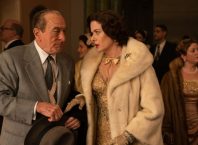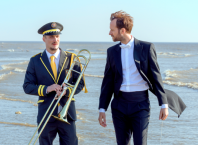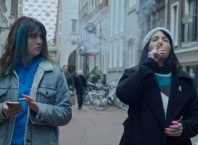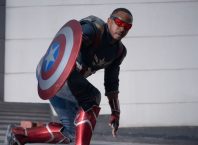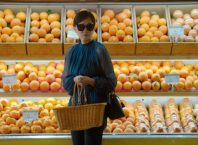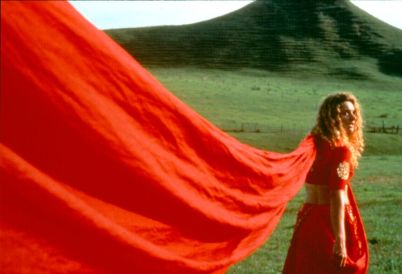 By Shlomo Porath
By Shlomo Porath
ONE of the best aspects of going to a film festival, that is very difficult to find in one’s general film-going, is surprise. The surprise at discovering a film one knew absolutely nothing about going in. Although seeing several films in close proximity can erode one’s appreciation of each individual film, a festival gives a unique opportunity and excuse to go to see a film absolutely cold. And what results is a very powerful and unique reaction to the films….for good and for ill. So what follows is my reaction to three films from the past few days of the New Zealand film festival. A reaction I most probably would not have had in other circumstances, and one that gave a great shot in the arm to my enthusiasm about film going, during this dry spell for theatrical releases.
The first film I saw probably benefited the most from my total lack of knowledge about it. It’s a film that I could see myself disliking if I came across it under different circumstances. But I was absolutely charmed by it.
The Price of Milk (2000), written and directed by Harry Sinclair, tells the tale of Lucinda (Danielle Cormack) and Rob (Karl Urban, of Lord of the Rings fame), an unmarried handsome young couple living in a small house near the dairy farm Rob owns and works in. Through all kinds of mostly preposterous developments, they break-up. They get back together in the end, presumably to live happily ever after. That’s what the film is about, like hundreds of romantic comedies before it. But, unlike so many other romantic comedies, this film is aware of that. What it sets out to do from the very beginning, is charging the story with enough wit, charm and quirk to make the story come alive. It’s entirely formulaic in it’s plotting, but feels vital and creative in its execution.
Take the very first scene of the film: the main credits sequence. Instead of super-imposing the credits on the footage, this is one of the only cases I’ve seen where the credits exist within the scene. Sewn on, in fact, in colorful letters, on a quilt. The quilt is being moved, each time revealing a new credit, a new name. It takes a few seconds for one to realize, that, in fact, the quilt is being tugged, back and forth, by our two main characters. They’re lying in bed, silently fighting over this quilt. A low-key opening, which could be taken for shameless quirkiness, but in this unassuming film, felt like the beginning of something a bit special. The opening of a film is all about setting the mood, and after the credits, with a quiet precision, the film introduces one interesting and witty composition after another, making particularly good use of its setting- the lush, beautiful green mountains of New Zealand. Even at points where I would have expected and accepted a straight-forward composition, the film surprised me.
That surprise is what kept me with the film. At times it almost over-dosed on quirkiness, with an agoraphobic dog (who walks around in a cardboard box), and a corner that everyone always takes too quickly, always flipping their car over. And it has many moments of outlandish surrealism. The last third of the film, in fact, does become a bit too surreal, though it does serve to enhance the love story (like a lot of romantic comedies, the plot is just a ridiculous concoction to keep our lovers apart as long as humanly possible, because they’re so naturally perfect for one another). But it did such a good job of setting its tone and creating likable characters that I was with it until the end.
Karl Urban and Danielle Cormack are wonderful in the leads, Urban particularly adept at conveying pure innocence without getting on our nerves, which can be a hard task. Both succeed at grounding this tale, which is really trying to be a modern fairy-tale. Even when everything around them spirals out of control – backstabbing best friend, an elderly Maori woman obsessed with staying warm, her terrifying looking but quite genial golf-playing nephews, the aforementioned agoraphobic dog, and a slightly creepy abundance of baby shoes- you really want to see them get back together. Which, of course, they do; in another simple, but endearingly creative bit of choreography/composition.
What it lacks in some aspects, it makes up for with an abundance of good-will and creativity. I adored this film.
Unfortunately, my reaction to The Price of Milk was not duplicated with the next film I saw, Rain (2001), by director Christine Jeffs. Like the previous film, I suspect my reaction would have been quite different under any other circumstances. In this instance- I absolutely hated the film. I considered walking out at several points. Although the filmmaker obviously had a passion for the subject, I felt that I was in the hands of someone not qualified to make a film; someone who seemed to think that pure intentions should be enough for the audience. The film is about a teenaged girl, whose own sexual awakening, confusing enough on its own, is compounded by her knowledge that her mother is having an affair.
A quiet, meditative film, one that I suppose could be described as ‘artfully artless’ (a term used to describe many post-modern neo-realist films), although ‘severely lacking artistry’ and ‘dull’ are better terms, in my opinion. The film jarringly moves from one overlong scene to another, seemingly to create a rhythm that makes the cuts less jarring, although in effect, they just make the film feel interminably long. Information about our characters is bluntly revealed in one scene, and then repeated ad-nauseum in one painfully slow scene after another. Unfortunately, many filmmakers are under the impression that a slow pace gives their films a kind of purity. I’m of the opinion that a particularly slow pace needs to be earned. If you want to have a meditative film, you better give me something to meditate on in the patches where no new information (whether plot or character oriented) is given. I thoroughly disliked this film. Its good intentions were poorly served by its execution.
Last, but certainly not least, I saw director Robert Sarkies’ Out of the Blue (2006). The small settlement of Aramoana, with a population of roughly 300, is a modest, lower middle-class town on the south isle of New Zealand. It’s the kind of place where everybody knows everyone else, and is generally a peaceful place. It’s right on the coast, and has beautiful picturesque beaches, mountains and sunsets. One day in 1990, two of its residents, Garry Holden and Julie-Anne Bryson, both divorcés with children, decide to move in together. They have a peaceful meal. Garry goes with the children to get some tools in order to fix a bicycle. David Gray, the reclusive neighbor, throws a fit when he sees the children walking on his property. Garry tells him not to yell at the children. Gray walks into his house, comes out with an AK-47, and shoots Garry in the chest.
That description is a more or less how the first quarter of this film plays out. A lot more happens, several character are set-up, the routine of different characters are shown (Gray included). But that should give one an idea of the film. Much like Gus Van-Sant’s Elephant (2003), the film shows you a rather mundane, uneventful life-style, playing out very lazily. Just when you’re settled in, a shocking, horrifying act of violence explodes any semblance of normalcy. The rest of what follows is a harrowing, shocking, painfully sad blow-by-blow depiction of a gunman on the loose, with the police attempting to take him down.
I knew almost nothing about this film going in, but I did know that it was based on a true event (I can’t imagine how this would play out if one did not know that). On November 13th, 1990, 33 year old David Gray went on a rampage that became known as The Aramoana Massacre, the deadliest shooting in New Zealand’s history. 13 people were murdered.
The film brought to mind two films- the aforementioned Elephant, and Paul Greengrass’s United 93 (also from 2006), both films that attempt to cope with horrific crimes in the recent past (Columbine and 9/11, respectively). Like Van Sant’s film, it comes to a slow boil, than explodes. Like Greengrass’s, it aims to recreate the sights, sounds and emotions of the event, with a hope that dealing with the event head-on might be able to offer some sort of catharsis for its audience. But it offers something that, while not necessarily lacking in those two films (which I am a big fan of), makes the film carry an extra sadness, apart from its visceral effect on the audience. Those early scenes, which work to set up the quiet normalcy of the town, also serve to introduce the audience to the people of the town. Not in a didactic way- it just lets the characters quietly take shape. When the shooting starts, those few minutes dedicated to let us roam the town, seemingly aimlessly, really pay off. This is one of the few recent films I can think of where death means something. We see death in film all the time. But only very rarely does death in film carry a genuine sadness to it, without any melodrama. Death in this film is brutal, ugly, and heart-wrenching. As hard as that is to watch, it was a welcome antidote to the desensitization towards violence that most films employ and count on.
The film is very spare, plot-wise. No back-story, no narration. No relief, either. Once the shooting starts, it doesn’t really stop for the rest of the film. And, appropriately enough, the camera seems to be almost entirely hand-held during the violence. I have my reservations about the use of shaky-cam in film today, but even though it did leave me with a slight headache, it was absolutely the right way to go here. A look aestheticized to the point of feeling staged would have crippled the film, which achieves that ‘you are here’ feel so many projects yearn for without justification (beyond lack of imagination). There’s almost no music in the film.
There’s not much to say about the acting, aside from saying that it’s utterly convincing. Karl Urban is the most visible member of the police force trying to capture Gray, but there aren’t any grand heroics on display. In fact, the actor who probably gets the most screen time is Matthew Sunderland, as Gray himself. It is a terrifying performance, all the more so because we’ve been given little information about him, aside from a few nuggets about his current occupation, mostly revolving stock-piling weapons and ammunition. Gray is presented as a man who is so obsessed with hatred for his neighbors that all other human emotion seemingly ceased to exist long ago. He lives entirely in the moment, and is totally unshaken by the violence he causes. At one point in the middle of his rampage, he enters a house, lights a cigarette, and goes to sleep.
Description of the rampage itself would serve little purpose, as it seems to be entirely factual, and avoids even the ripest chances for melodrama by undercutting them with simple, straight-forward, recognizable humanity. The respect for the victims keeps the film from feeling exploitative or sadistic, and the meaning and emotion it returns to the image of death and suffering helped it achieve rare nobility, at least for my money. This is a powerful and sorrowful film, one that left me shaken up for the rest of the evening, and one I’m sure I’m going to be reflecting on for days to come.

